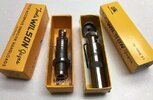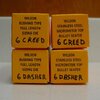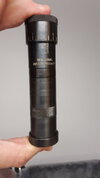An interesting thing happened here: a large percentage of the responses were progressive press users presenting arguments why the OP “needs” a progressive. It almost reads like an intervention.
But the really interesting thing is, several respondents said they did not have, and would not have, a single stage press - and not one person tried to convince them otherwise.
Very interesting.

I haven't tried to convince anyone to do anything, but in post #11 I did indicate that I have both and provided reasons why I prefer a single stage over a progressive. I noted that it is possible to produce precision cartridges on a quality progressive, but that it is not done progressively. To recap:
# progressive operation must be interrupted to clean the cases once they are sized with lube and de-primed.
# progressive operation is likely to need to be interrupted to trim the cases with precision.
# progressive operation is likely to need to be interrupted to chamfer and debur the case mouths.
# progressive operation may need to be interrupted to prime the cases.
# progressive operation may be interrupted once brass processing is complete to await powder and bullet selection.
# progressive operation will need to be interrupted to meter and trickle powder with precision.
# charged cases cannot be re-inserted via the case feeder but must be placed in the shell holder by hand.
# bullet seating on various progressive shell plate positions is not likely to be consistent.
I am not disputing that precision ammo can be made on a progressive. I believe it can. However, it is not done progressively, but using the press as a single-stage.
I do use a progressive, and the most useful feature is the case feeder. Whether I use a progressive or a single-stage, I process all my brass in advance and store it fully-prepped. I do this to thousands of cases at a time. When I finish brass processing is not necessarily when I want to make charging and seating choices and complete the cartridges. If I want to test several different powders, bullets, seating depths or whatever, I don't want to have to begin at step one with dirty fired cases.
I'll put it this way: for the price of a Dillon I can have many hundreds or even thousands more pieces of the best quality brass fully prepped and on-hand to be charged with a precision method not possible on a Dillon, and then seated with precision on a single-stage press. A person considering buying an expensive progressive press should consider the alternative of buying more brass instead of hoping to cycling the same few pieces more times. With more brass, press operations are required less often, and so is cleaning and everything else. People considering buying a progressive are often hoping to save their time. Buying more brass is a better time-saver. With enough processed brass on hand, a person will not need to sit at the press processing brass. I only process brass a few times a year. If I was finding myself having to do it monthly, I would buy more brass, not a progressive press. What about those few times a year I process many thousands of cases? I do use a progressive, but I noted already because of all the interruptions of progressive operations noted above, the case feeder is the most time-saving feature. Case feeders on single-stage presses are the solution. My Lee APP Deluxe does that. I will also note that feeding cases to and from a single stage can be very quick. I pick a case, pull a case from the shell-holder with the same fingers, insert the picked case and while I'm pulling the handle with the other hand, the first hand is placing the processed case and picking the next case. This cuts hand movements between the bin or block and the shell-holder in half, so that I'm pulling the handle about 60 times in a minute.





